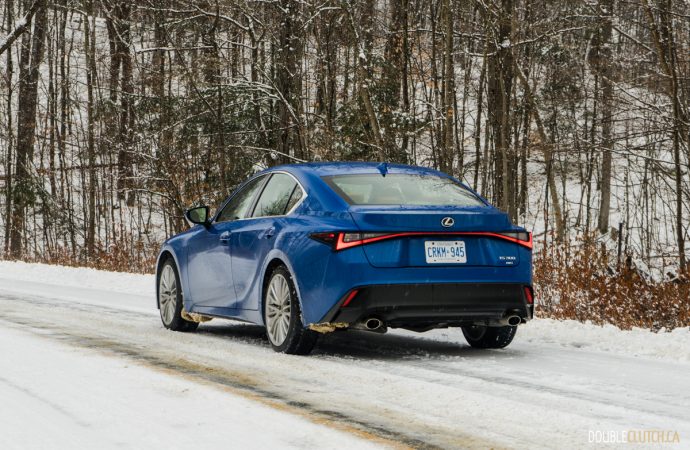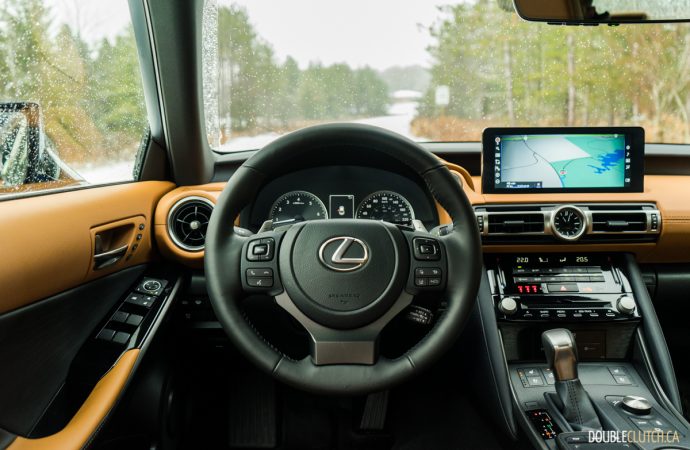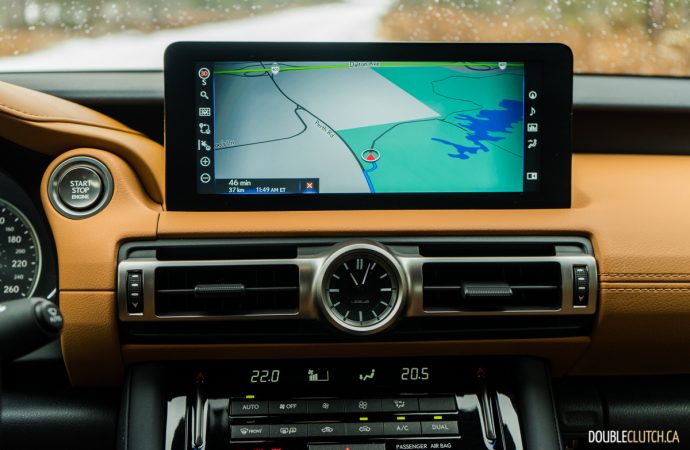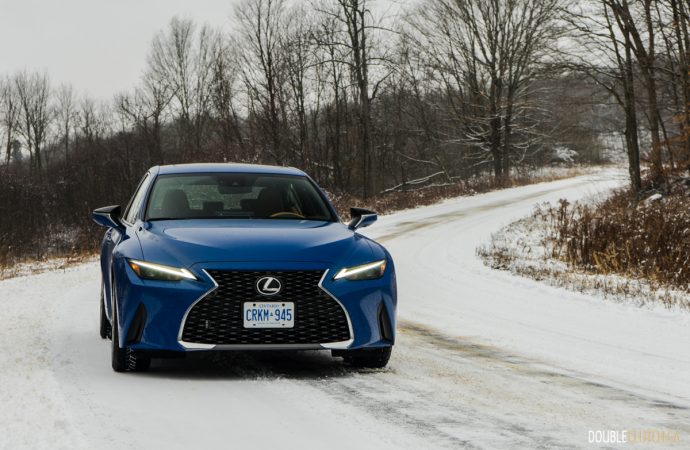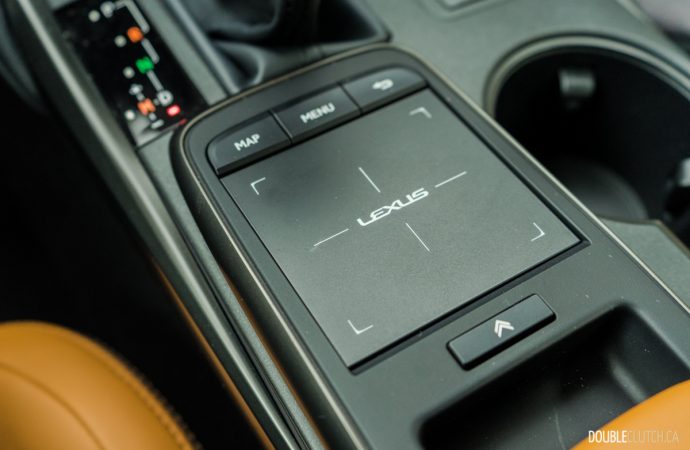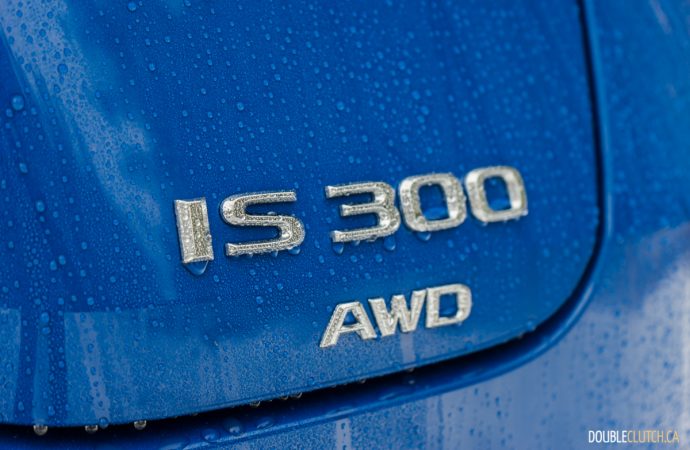KINGSTON, ONTARIO – After seven whole years of the previous generation, Lexus has finally graced the market with a redesigned IS. Since the model’s inception at the turn of the century, the IS has been popular with both enthusiasts and young professionals; those who cherish their entry level sport sedan’s driving dynamics just as much as reliability over longer term ownership. The outgoing model has some pretty substantial shoes to fill, so we were eager upon receiving an invitation to spend a day behind the wheel of the 2021 Lexus IS 300 AWD.
So the elephant in the room with regards to the IS is competition. While the car is technically a rival to the likes of the BMW 330i and Mercedes-Benz C 300, it’s substantially cheaper with a starting price of just $42,950. The V6-powered IS 300 AWD starts at an aggressive $43,400 with 260 horsepower on tap. It’s about the same size as the Germans, but buyers are really cross-shopping the IS 300 with the Infiniti Q50, Genesis G70, and Acura TLX. This isn’t a bad thing by any means.
The IS 300 is the pinnacle of build quality and longevity in its class. The previous generation was revolutionary in its aggressive, futuristic design, and time has been kind to it. The latest model is an evolution on that one, and understandably so considering it uses the same platform. It’s more appropriate to call the fourth-generation IS 300 tested here a significant mid-cycle refresh rather than an all-new car. It looks fresher on the outside, with an aggressive stance, and a more tucked design than before. It’s still absolutely a looker.
On the inside, the new IS isn’t as much of an update as we would have expected. The infotainment system has been substantially updated with a 10.3-inch touchscreen, finally implementing Apple CarPlay and Android Auto, and a slightly more intuitive touchpad. The latest version of the Lexus Safety System+ is on board, including radar cruise control, pre-collision systems, a new Left Turn Intersection Support feature, and more. But that’s about where the interior updates end.
The cabin looks largely the same as the outgoing car, with a massive transmission and driveshaft tunnel, and a huge hump cutting into the driver’s legroom. Rear accommodations seem to have improved slightly, and this is one area where the IS gets a nod over the Genesis G70, and as expected from Lexus, materials are still top notch for the most part. It must however be mentioned that our Ultra Luxury trim tester had some hard plastics on the dashboard that looks like it should be simulating leather, but feels cheap to the touch.
That said, the NuLuxe seats are superbly comfortable and extremely supportive for longer distances. The side bolsters hug occupants perfectly and while some more adjustment or thigh support wouldn’t hurt, these seats surpass the current Audi A4. They are also heated and ventilated, and the steering wheel is heated as well.
Three powertrain options are available on the new Lexus IS. The base IS 300 with rear-wheel-drive starts with a 2.0-liter turbocharged inline four-cylinder. Output is 241 horsepower and 258 lb-ft. of torque, which is “just enough”. The IS 300 AWD is the one most will buy, with a de-tuned version of the IS 350’s 3.5-liter naturally aspirated V6. It gets 260 horsepower at 6,600RPM and 236 lb-ft. of torque, and obviously directs power to all four wheels with a rear-bias. The top-trim IS 350 AWD gets a 311 horsepower version of the V6, which is where the line currently tops out.
Sending this power to the wheels in the all-wheel-drive models is a six-speed automatic transmission, which happens to be the biggest downfall of the new IS. An eight-speed unit is available, but only on the rear-drive IS 300 that is likely to gain minimal traction (pun fully intended) in the Canadian market. This was an omission back in 2014 when the previous generation car came out, and is a bit of a disappointment here as well. Two more gears on the all-wheel-drive model would go a long way towards improving fuel economy.
Despite the IS 300 lacking two gears, it’s a great driving companion. Acceleration is strong and neutral, and the naturally aspirated V6 has a satisfying roar to it. Power comes on immediately with no lag, and putting the transmission into manual mode affirms the responsiveness of the paddle shifters. The IS handles sharply, and Sport mode adds some very real-feeling weight to the electrically assisted power steering. The chassis responds well and the car is eager to toss the rear end out if pushed hard. Our test took place on a snowy day so we were able to conduct some very scientific testing.
Lexus Canada rates the rear-drive model at 11.0L/100km city, 7.6L/100km highway and 9.5L/100km combined. Stepping up to all-wheel-drive and both tunes of the V6 pushes these numbers to 12.2L/100km city and 9.0L/100km combined. All models get a 66-liter fuel tank, and premium 91-octane is required for optimal performance. Again, two additional gears would help efficiency significantly.
Canadian buyers will find a nice companion in the IS 300 AWD. A nice upgrade is the Ultra Luxury Package on the IS 300 AWD, which adds a plethora of things including a power moonroof, surround-view camera system, adaptive headlights, 19-inch alloy wheels, heated and ventilated front seats, 17-speaker Mark Levinson audio, and more. It adds $7,600 to the $43,400 price of the car, bringing it to $51,000. Cheaper packages are also available with varying equipment. Those wanting the larger engine can step up to the IS 350 AWD at $53,500, where a $4,700 F-Sport Series 3 package is the only available upgrade.
As long as we look at this model as a mid-cycle refresh, the 2021 Lexus IS 300 AWD is an excellent car to live with. While it may be a disappointment to those expecting a completely overhauled model, it’s still one of the best in its segment in terms of long term ownership experience. The naturally aspirated V6 is the only one in its class, and Lexus continues to sit at the top of all reliability ratings. This is a safe choice, and a good one at that.

